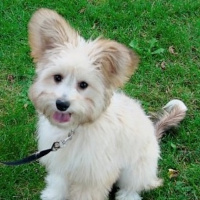Appearance of the Westillon
|
| The Westillon has a long coat inherited from its two parent breeds. The coat can be entirely white, like that of the Westie, or white with markings of all colors, as in the Continental Toy Spaniel. The coat can be soft like that of the Continental Toy Spaniel, or rough like that of a traditional Terrier, or somewhere in between. The Westillon has round, brown eyes and a black nose. The hair around the eyes, ears and feet is longer than the rest of the coat, giving it the appearance of a teddy bear. Its ears are large, straight and point forward. Its body is rectangular, its legs slightly shorter than its abdomen. Its tail can be straight or curl over its back. The skin around the eyes and mouth is black, and the teeth meet in a scissor-like pattern. |
Temperament of the Westillon
|
| Westillons are outgoing, confident dogs, just like their parents. Their personalities are much larger than their small bodies would suggest. They could be described as "type A", as they prefer to go on adventures rather than cuddle. But they don't want to go it alone. Although independent, these dogs love to be with their humans and can develop separation anxiety if left alone for too long. They are protective and will raise the alarm if someone comes to your door, but they will quickly make friends, making them poor watchdogs. The West Highland White Terrier and Continental Toy Spaniel generally get on well with other dogs, so we can assume the same applies to the Westillon. However, Westies are known for their hunting instinct, and Westillons may be inclined to chase cats and other small pets. Westillons are young at heart and love the energy of youth, but they may not be perfect with children as they are feisty and can become snippy when irritated. However, if socialized with children who respect their limits, they will make excellent companions. These intelligent dogs are easy to train, but they can inherit the Westie's stubborn attitude. Reward-based training is therefore likely to be the most effective. |
Needs and activities of the Westillon
|
| The Westillon is an energetic dog, and should be walked or played with for at least 30 minutes every day. Both breeds are energetic and intelligent, which means exercise is important for both body and mind. Westillons love the opportunity to explore and run around. They play well with other dogs and will probably make excellent dodgeball partners. When they've had their exercise, they're happy to spend time with you at home, but they like to have toys to occupy themselves in their spare time. Westillons make excellent apartment pets, provided they get enough exercise, otherwise they risk barking and annoying your neighbors. They love to run in fenced-in yards, or just hang out with you. They thrive in most climates, but their Continental Toy Spaniel cousins have no undercoat and are therefore very sensitive to the cold. Be sure to buy your Westillon a warm jacket if you live in a colder climate. |
Maintenance of the Westillon
|
| The Westillon inherits a medium to long outer coat from its two parent breeds, and may also inherit the Westie's thick undercoat. Despite its length, its coat is easy to care for and doesn't shed much. Weekly combing removes tangles and knots. Dirt can generally be brushed off, and the odor level of both parent breeds is low, so Westillons can be bathed as needed. It may be necessary to trim the hair around the eyes, ears and legs, as these are the areas most prone to matting. These dogs are prone to ear infections, as their long hair can trap dirt and moisture inside, so check weekly for signs of irritation. Daily tooth brushing is also recommended for small dogs. |









 English (United Kingdom)
English (United Kingdom)